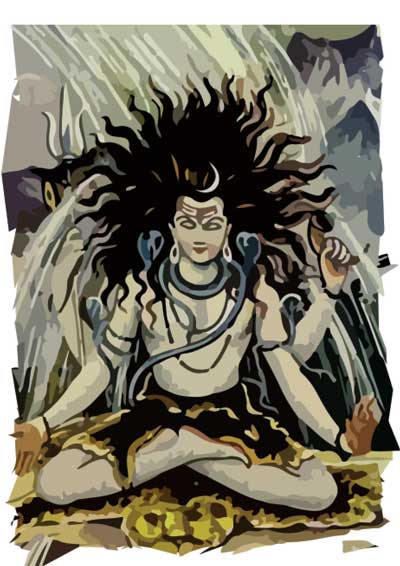Shiva as Rudra, the Vedic Connection

The ancient Vedic people worshipped a fierce celestial deity of storms, known as
Rudra, who, according to many scholars, was none other than a prototype of Lord
Shiva. Rudra being an epithet of Shiva, both are viewed as one and the same in Hindu
tradition. Rudra means the one who is red or fierce. The ancient Vedic Indians feared
Rudra for his ability to cause death and disease. They also revered Him for his
ability to protect people from sudden death and snake bites. The Vedic hymns described
Him as the god of roaring storms and ancient healer. The Rigveda (2.33) describes
Him as the "Father of the Maruts", a group of storm gods. One of the most
sacred hymns of the Vedas is Rudram, found both in the Rigveda and Yajurveda, which
invokes Rudra and mentions the name Shiva several times, not in the current sense
but as an epithet of Indra, Mitra and Agni. While popular tradition holds the Vedic
Rudra and Shiva as one and the same, some scholars such Axel Michales disagree on
the grounds that there is not sufficient justification to connect the two.
The Rigvedi hymns describe Rudra as as Sarva (the Archer), a name by which Shiva
is also known popularly and name which alludes to his conneciton with ancient non-Vedic
tribes. It is also included as one of His 1000 names, which are used in his ritual
worship. In the Mahabharata, Shiva appears to Arjuna as an archer only. The name
Sarva, means the one who injurs or kills, the same attributes with which Rudra is
deified in the Vedas.
Identification with Vedic deities
In the Vedic literature, Shiva was closely identified with other Vedic deities such
as Agni, Indra, Prajāpati, Vāyu, and others.
Agni
According to some scholars, the identification between Agni and Rudra in the Vedic
literature was an important factor in the process of Rudra's gradual development
into the later character as Rudra-Shiva.. the Nirukta, an ancient text of Sanskrit
etymology, draws the connection between the two, saying Agni is also Rudra. Agni
being the sustainer as well destroyer of life, the connection between the two is
inevitable. According to Stella Kramrisch, The fire myth of Rudra-Śiva plays on
the whole gamut of fire, valuing all its potentialities and phases, from conflagration
to illumination. The similarities between the two deities is evident in the Satarudriya
(Rigveda), where some epithets, such as sasipanjara (of the golden red hue) and
tivasjamati (flaming bright) envision Siva as a God of fire. In some of the Vedic
hymns Agni is also described as a bull and bull, known as Nandi, is the vehicle
of Shiva. In some texts Agni is described as Bhairava, which is one of the epithets
of Shiva. Shiva's association with Agni is also evident in the symbolic presentation
of Shiva as the Lord of Dance (nataraja), where he is shown dancing in a circle
of fire.
Indra
Indra was the supreme deity of the early Vedic religion. He is considered to be
the God of thunder and the Lord of the heavnes. He wields lightning as his weapon,
slews the dark monsters (clouds) of the skies and releases the water for the welfare
of the people on earth. He also sends terror in the hearts of the enemies of His
worshippers. He is described as a great warrior who destroyed several cities ruled
by evil demons. According to some scholars as the popularity of the early Vedic
deities decline and new gods such as Shiva and Vishnu emerged on the scene, some
of the early descriptions associated with Indra were subsequently transferred to
Shiva. According to the Indologist Koenraad Elst, there are reasons to believe that
Shiva of Puranic Hinduism is a continuation of the Vedic Indra. For example, both
Shiva and Indra are known for their addiction to Soma. Both are associated with
such popular symbols as mountains, rivers, male fertility, fierceness, fearlessness,
warfare, transgression of established mores, the Aum sound, and the Supreme Self.
Besides in the Rig Veda, the term Shiva is used as an epithet to describe Indra.
(R.V 2.20.3, 6.45.17,and 8.93.3)
Source: Some content for this article is adapted from Wikipedia.org with necessary
changes.